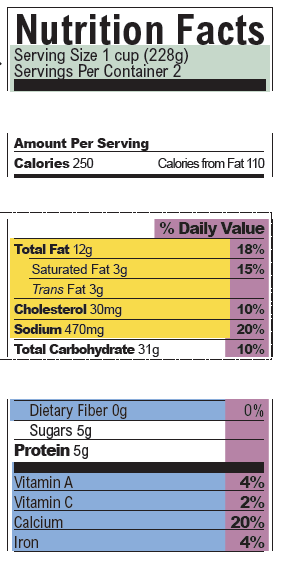making sense of food labels
Welcome back to our "Tracking Your Food" series! In the last lesson, we learned how to start tracking our food using a Food Log. Now, we're taking the next step: making sense of food labels. Get ready to unlock the secrets hidden in those labels!
Welcome Food labels are like magic books. They tell you all about the food's secrets, like how many calories are inside and what nutrients it has. One essential thing to understand is the serving size. It's like knowing the size of the puzzle piece you're dealing with.
In this lesson, we'll dive into food labels and uncover how to read them. By understanding serving sizes, calories, and Percent Daily Values, you'll become a food label expert.
So, let's get started with Lesson 3 and become food label wizards!
Understanding Food Labels (look at the example label below)
Serving Size: Start by checking the serving size. This tells you how much of the food is considered one portion. All the other information on the label is based on this portion size. If you look at the label and see that there are two servings in the package, it means if you eat the whole package, you'll need to double everything on the label. You can use a calculator if that helps.
Calories: Understanding the number of calories can help you keep a healthy weight. Calories tell you how much energy you get from one serving of the food. Many people in the U.S. eat more calories than they should. Try to make sure that less than 30 percent of your calories come from fat.
Limit Fat, Saturated Fat, Cholesterol, and Sodium. Many Americans get plenty or even too much of these nutrients. Eating too much fat, saturated fat, trans fat, cholesterol, or sodium can increase your risk of certain health issues. These problems may include heart disease, some types of cancer, and high blood pressure. It's important to be mindful of these nutrients in your diet.
Get Enough Fiber, Vitamin A, Vitamin C, Calcium, and Iron. Many Americans don't eat enough fiber, vitamin A, vitamin C, calcium, and iron. These nutrients are really good for your health and can reduce your risk of certain health issues. For example, having enough calcium can make your bones and teeth strong. Eating lots of fiber can help you shed extra weight and reduce your cholesterol levels. So, it's important to make sure you're getting plenty of these nutrients in your diet.
% Daily Value: The Percent Daily Values show you how much of the nutrients you need in a day are provided by one serving of this food. These values are calculated based on a daily diet of 2,000 calories. But if you eat more or less than 2,000 calories a day, your Percent Daily Values will be different. So, keep in mind that these numbers can change depending on how many calories you usually eat.
Other Ways to Find Out Nutrition Facts:
In addition to reading food labels, you can also use different tools to find out more about the nutrition of the foods you eat. You can try computer apps, smart phone apps, websites.
These can help you make informed choices about what you eat and how it affects your health. So, don't hesitate to explore these resources for even more information!
Sample Label for Macaroni and Cheese

